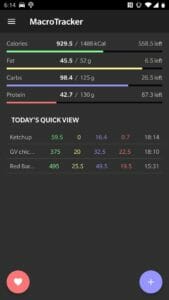Overtraining is defined as: “when the body is subjected to excessive physical stress without adequate…

How Counting Macros May Help You Reach Your Pole Goals
We’re well into the new year but I hope you’re still psyched about all of your pole goals and that they are going well! I personally have a few goals myself, one of which is to get stronger so I can start conquering those more challenging pole moves. For a lot of us pole dancers, getting stronger is something we are constantly working to improve on. I want to share with you how I’m working towards that goal in the hopes that it may help you too.
We have all heard many times before from our pole instructors that exercise and nutrition play a key role in performing well and and conquering those difficult moves. Pole is a great combination of both cardio and strength training so for many of us exercise it’s an easy box to check off. But for me, like many, nutrition can be a more difficult challenge. I only recently started questioning if I was feeding by body what it needed to meet my goals. So how do you determine if you are getting the right nutrition? For me, I found that tracking my macronutrients is a great way to see if I’m getting the proper nutrition.
What are Macros?
If you don’t already know, macronutrients refers to fat, carbs, and proteins. Why are these three things necessary for proper nutrition? Well, fat supports cell growth and hormones, carbs give you energy, and protein is essential for muscle building. The idea of tracking your macros means you are ensuring that your body is getting the right amount of these three things.
What are your goals?
But what is the correct amount of macros for you? First, you need to determine what your goals are so that you can determine what your macro build should be. My goal is to gain muscle so I can get stronger, so I favor a protein focused macro build. More specifically, my daily food intake is around 42% protein, 41% carbs, and 17% fat. But maybe you do more cardio than strength training and need more energy; then you might take a more carb focused approach. Or maybe you’re going keto and want to ensure you are getting enough fat and not too many carbs. If you’re not sure what macro build is best suited for you and your goals, you can check this video here to get some ideas on macros builds and their percentage split ups. Though it’s always best to talk to your doctor first before making any big changes.
Time to start counting!
 Once you’ve determined your goals, macro build, and percentages, it’s time to figure out how many grams of each macro you need. This will depend on several things: sex, age, activity level, weight, and height. This may seem like a lot to consider but there are many macro calculators out that make the process easy. Just make sure you are specific in what kind of macro calculation you need. For example, google “keto macro calculator” or “bodybuilder macro calculator” , rather than just “macro calculator”; otherwise you might not get the wrong calculation.
Once you’ve determined your goals, macro build, and percentages, it’s time to figure out how many grams of each macro you need. This will depend on several things: sex, age, activity level, weight, and height. This may seem like a lot to consider but there are many macro calculators out that make the process easy. Just make sure you are specific in what kind of macro calculation you need. For example, google “keto macro calculator” or “bodybuilder macro calculator” , rather than just “macro calculator”; otherwise you might not get the wrong calculation.
Though counting your macros takes a little research, I find it well worth it and way less restrictive than diets or meal plans. When it comes to eating, I only eat what I enjoy and I never make myself eat something I don’t like or want. I just eat what is best accommodating to my lifestyle and preferences. In fact, I’m still eating the same foods I did before counting macros; I’m just eating different portions of them when necessary so I can reach my goals. For example, I love pizza and chicken equally; tracking macros just means I now try to eat a little less pizza and a little more chicken when necessary. I track my macros on my phone through an app called the Macro Tracker; however, there are many more to choose from in your app store.
Nutrition is a journey
But don’t fret if you find yourself not meeting your macro goals. Everything is a process and it takes time to make changes and build habits. I personally prefer starting small and working my way up. For example, maybe your target goal for protein is 130 grams for the day but you typically only eat 70; start small and just aim for 80, then when you reach that, aim for 90. Or maybe instead of thinking about your overall daily macro goals, split it up to just 43 grams of protein per meal. Or? Maybe macros just doesn’t suit you and that’s totally okay. Nobody knows you better than you do so find your own process and kick butt on those 2020 pole goals!
Latest posts by Savannah Smith (see all)
- Pole Con 2021: My experience as an attendee - June 17, 2022
- Benefits of Foam Rolling for Pole Dancers - November 19, 2021
- Covid-19 and The Pole Industry: Part 8 - October 29, 2021


